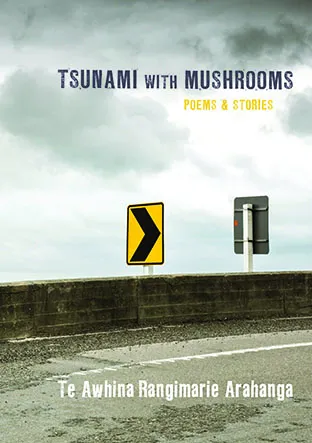Tsunami with Mushrooms
Tsunami with Mushrooms: Poems & Stories by Te Awhina Rangimarie Arahanga. Steele Roberts (2023). RRP: $25.00. PB, 174pp. ISBN: 9781738589272. Reviewed by Moata McNamara.

Te Awhina Rangimarie Arahanga, of Ngāti Tūwharetoa, Te Ati Haunui a Paparangi, and Ngāti Hauiti ki Rata descent, has a rich and varied background as writer, curator and heritage and historical advisor. This, her second book, following her poetry collection Darkness in Light, is packed with contemporary issues building on her background.
It was the title Tsunami with Mushrooms that first drew me to this book. How will the distance between these two nouns be written? The small word ‘with,’ in the title, sums up Arahanga’s expertise at weaving together the disparate topics covered, and the artists whose works are included. There is a generosity involved where Arahanga and her community host a hakari, a bountiful feast of word and images.
For there is community on every page, engaged with each other and with the whenua, the land they live on. A community where mountains ‘rolled up their sleeves of a shirt made from fabric stolen from cloud’ (p.16) and the sperm whale Matamata stands guardian. They are all related, and Arahanga skillfully writes these relationships with an intimacy to the many beings that inhabit this book.
Physical, cultural, environmental, educational and industrial safety are all at issue for this community. The 2016 Kaikoura earthquake, caused by the rupture of multiple faults in the area, still lives with the people and land. In the short story “Māori 101,” Arahanga addresses seismic rupture from inside the wharenui, where ‘the carvings are moving, breathing, slamming their hands upon their thighs with their pāua eyes blinking’ (p.42). The haka is loud and insistent. In the face of danger a community responds.
Later it is Covid that threatens, through a Zoom session of animals responding to David Attenborough’s desperate call for help. Like many other poems and stories throughout Tsunami with Mushrooms, there is an adept blend of humour and pathos. It is an earthy humour, directed at mountains, rockpools and cigarette butts, as much as friends and whānau. A humour growing out of aroha, out of relationships, out of a sense of being with, and of relating to.
This shows also through the artworks, where the writer is drawn, quoted and responded to with a series of works that are not additional to the text, but weave into it. Not an easy feat.
E te tuahine Te Awhina (Te Āwhina ranei), you have hosted us well. Your warmth and community wrap around your grateful readers from every page.
Ngā mihi nui.
Moata McNamara (Ngāpuhi, Te Mahurehure), artist and writer, has taught at many levels within Māori and tertiary education. She is currently teaching English and Writing part time at secondary level and working on a collection of her own poetic writings. With a strong interest in language in its many iterations, and in the book as one of those iterations, she approaches reading as a kōrero, a conversation with a writer. Thus a book is a call for a reader, an open karanga to approach, setting up the process for a hui, a meeting of words, bodies, through the haptic experience of the book as an object, minds, and sometimes hearts.